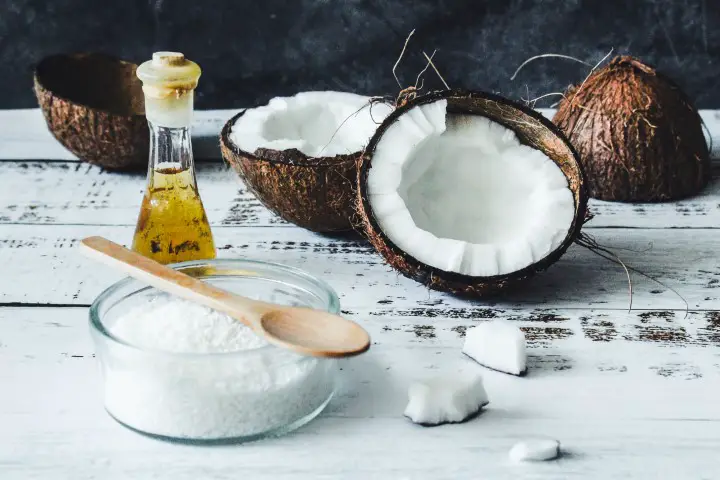 Coconut oil has a sweet and unique flavor, smell, and consistency, which is why a lot of people store them in their pantries for various recipes. But have you ever asked yourself “how long does coconut oil last?”.
Coconut oil has a sweet and unique flavor, smell, and consistency, which is why a lot of people store them in their pantries for various recipes. But have you ever asked yourself “how long does coconut oil last?”.
In today’s article, we’ll answer all your questions regarding its storage and shelf life. Let’s dive in!
Does Coconut Oil Go Bad?
In general, oils go bad by a process known as “rancidification”. It’s a process where the oils undergo chemical changes either by air, light, moisture, or bacterial action.
This results in the formation of rancid oils, which might look the same but will have an unpleasant taste and odor due to the creation of new compounds in the oil.
When it comes to rancidification, some oils will give in much quicker than the others.
And while a lot of people think that, similar to honey, it doesn’t go bad, it does. However, it is generally one of the most sustainable types of oil out there, as it can last for a surprisingly long time!
In fact, there are some claims that it has one of the longest lifespans of all cooking oils out there.
One thing you should know is that different strains and types of coconuts will have a different composition of oils, and therefore, different shelf life. However, they all eventually go bad.
Also, despite its resilience, it can go bad in a variety of ways, including bacterial contamination, fungus and mold contamination, chemical changes, and more!
For that reason, a bottle of coconut oil will usually have a use-by date. But don’t worry, if you buy a fresh batch, you’ll have at least a couple of years before you have to worry about clearing it off your pantry.
What Is the Shelf Life of Coconut Oil Stored in Optimum Conditions?
As previously mentioned, you should expect a new batch to last anywhere between 1.5 to 2 years depending on how it’s stored.
In optimum conditions, it’s pretty easy for it to surpass the 2 years mark. Such a shelf life is a far longer than many other kinds of oil.
Of course, it doesn’t go bad out of the blue. It gradually starts to change and give off an overall lower quality before it’s completely unusable.
So, the word “going bad” here is highly subjective and depends on how you perceive the idea of going bad.
While a jar of freshly made coconut will last you up to 2 years on the shelf, you should expect it to give off a milder taste and flavor a couple of months earlier than that.
What Are the Main Factors that Spoil Coconut Oil
Similar to most food products, it is prone to spoilage due to a variety of factors that will mess up its chemical composition, producing by-products that are lesser in quality or totally unusable. Here’s a brief overview of the main factors that cause it to spoil:
Air
The fastest and most common process that renders the it bad is the oxidation process. And of course, the more air the coconut is exposed to, the faster it’ll go bad, which is why coconut oil is usually stored in air-tight containers, such as jars.
Light
Particularly sunlight, which contains ultraviolet rays that can speed up the rate of the oxidation process.
Keeping the coconut oil in an opaque jar and closed environment like a pantry should prevent that from happening.
Heat
Another factor that won’t only speed up the rate of oxidation, but the rate of any kind of spoilage is heating.
Of course, we’re talking slightly above room temperature heat and not cooking heat (about 80 to 90 °F or 26 to 32 °C).
Moisture
Another enemy to most food items is of course moisture. Moisture is responsible for a breaking down process known as “hydrolysis”.
In addition to that, moisture also attracts microorganism that can do further damage to your coconut oil, as you’ll see below.`
Bacterial and Fungal Infestation
Although coconut oil has natural anti-microbial abilities that prevent them from spoiling quickly, they’re still prone to some form of molding and bacterial contamination.
After all, an exposed jar of coconut oil is a highly nutritious medium that contains all the necessary components for these microbes to thrive.
What Gives Coconut Oil a Long Shelf Life?
An oil molecule consists in a long chain of fatty acids with bonds. The difference between saturated and unsaturated fat is the number of double bonds in the chain.
Saturated fats contain only single bonds, while unsaturated fats have at least one double bond in the fatty acid chain. The more unsaturated a fat is, the faster the oxidation reaction happens, and the quicker it’ll go bad.
Since it contains a lot of lauric acid, which is a saturated fatty acid (has no weak points), it’s usually solid, less reactive, and less prone to degradation.
However, “mostly” means that there are still some unsaturated bonds that will render it bad eventually.
Will Different Types and Grades of Coconut Oil Have Different Shelf Life?
The difference isn’t huge, but it’s still there. Coconut oil is classified into various types, such as virgin, refined, and hydrogenated, extra hydrogenated, fully hydrogenated.
Contrary to what you might’ve thought, non-processed coconut oil has a slightly longer shelf life than high grade processed ones. This is due to the oil being subjected to various processes that expose it to factors of degradation.
Fully hydrogenated coconut oil is the thickest in form and has the lowest number of unsaturated double bonds. This makes it a little more reliant and long-lasting.
What Happens if You Consume Spoiled Coconut Oil
If you unknowingly consumed spoiled coconut oil, whether by ingesting it or using it in skin masks, you shouldn’t freak out.
Aside from the terrible taste and obvious signs that you shouldn’t taste such oil, if you happen to ingest any food made with rancid coconut oil, you might not be affected. In fact, you might not feel ill or have a stomach ache at all!
As for using it for skin recipes, it might give off a repulsive strange smell. The worst it can do is simply not have any benefit. So, no worries here!
Despite that, you should know that rancid oils, in general, carry a long term health hazard if you continue to consume them, as they contain free radicals that can mess up your DNA, causing cancer as well as liver diseases.
How to Tell that Coconut Oil Has Gone Bad
Since you don’t want to consume bad coconut oil you might be asking, how to spot it when it happens. Luckily, rancid coconut oil will have various signs that you can easily spot.
The Appearance

Coconut oil of high grade will usually have a translucent to whitish thick texture and becomes completely clear when melted.
If you noticed the jar is getting a strange yellow tinge to it, it is getting rancid due to oxidation. Especially at the surface where it’s subjected to air the most.
Other forms of contamination might also show. For example, if you find the coconut oil chunky or blotchy, that might be due to moisture degradation. Little whitish spots are just coconut oil that isn’t melted yet and are not a sign of bad coconut oil.
The most obvious, and dangerous, sign to never miss is the presence of dark green, brown, or black spots on the jar or the coconut itself. This is usually due to fungal or bacterial infection and should be discarded right away!
The Smell
When you open a jar, you know the smell you’re going to expect. A stale or minimal one is a sign that the oil isn’t bad but is very close to becoming spoiled. If it has gone rancid, it will be extremely sour and repulsive.
The Taste
If the it looks fine but tastes a little off or very mild, this is another clear sign that the coconut oil is about to go rancid.
How to Store Coconut Oil Properly So It Doesn’t Spoil
The optimal condition for storing coconut oil is by keeping it in an airtight container. You should also make sure to rest it in a dark and dry spot, such as your pantry.
Wrap Up
With that said, you now have a complete answer to the question “how long does coconut oil last?”.
By keeping fresh coconut oil locked in a cool dry pantry and inside an airtight jar, you can rest assured that it’ll last you for 2 years. However, you can extend it to more than 3 to 4 years by freezing!
